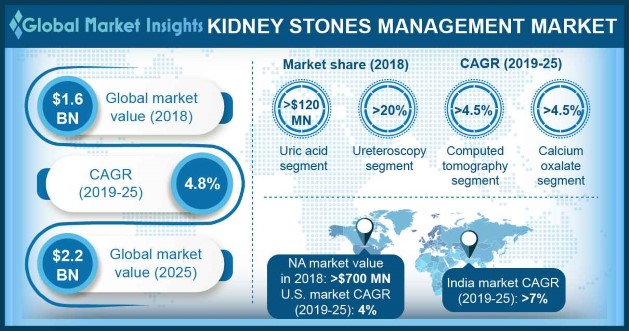Kidney stones management market to be characterized by increasing emergence of new technology trends, intensive research and development activities to push industry growth
Publisher : Fractovia | Published Date : July 2018Request Sample
The surging need for minimally invasive procedures to escalate the treatment of urinary stone-afflicted patients will drive kidney stones management market share. Healthcare service providers have long since been encouraging early diagnosis of kidney stones – a step that has a major role to play in the management of this disorder. Amidst the backdrop of a scenario that suggests untreated kidney stone disorder to lead to bladder cancer, the awareness for early diagnosis has gained renewed importance. With the rising availability of advanced diagnostic equipment such as CT scan and other imaging devices, medical companies have also been working toward brainstorming new diagnostic procedures, impelling kidney stones management industry size.
U.S. Kidney Stones Management Market Size, by Treatment, 2013-2024 (USD Million)

Several initiatives undertaken by private hospitals have played a part in kidney stone management. For instance, recently, the Norwalk Hospital introduced a pain management program for the patients suffering from a backache, headache, and kidney stones, devoid of opiate usage. The managing committee of the hospital has taken over the responsibility of educating patients about the benefits of various remedies for kidney stones, apart from conventional drugs, via this pain management program. It is rather overt that such remedy programs would tend to contribute significantly toward treating the increasingly occurring cases of kidney stones across U.S., augmenting the regional kidney stones management market share. For the record, in last 15 years, the prevalence of urinary stones in U.S. has doubled, affecting 1 in 11 people.
The involvement of hospitals and medical research communities via high-quality research and development programs related to innovative therapies for treating patients with urinary stones will have a remarkable impact on kidney stones management industry outlook. In order to encourage research communities and healthcare service providers to continue their efforts in raising the awareness regarding kidney stones, many organizations have been financing a slew of research programs conducted by the aforementioned parties. Citing an instance, the United States medical research agency, the National Institutes of Health (NIH), commenced a clinical trial last year called PUSH (Prevention of Urinary Stones with Hydration) to reduce the recurrence of urinary stone diseases. The National Institute of Diabetes and Digestive and Kidney Diseases has also supported this clinical trial to encourage researchers to identify effective stone prevention strategies.
Speaking about the development of treatment facilities, in 2015, the University of Zurich, based in Switzerland also carried out a clinical trial on about 1282 patients, subsequently unearthing ureterorenoscopy (URS) to be one of the effective treatments for the disorder. Reportedly, all the patients in the trial had a stone of diameter 5 mm to 20 mm, left untreated. The trial results however revealed that patients treated with URS depicted a stone-free rate of 84% and a freedom from reintervention rate of 79% - thereby making ureterorenoscopy a highly effective treatment method for this disorder. The trial also brought to light, the fact that over the coming years, kidney stones management market will collect significant revenue owing to the growing popularity of technologically advanced treatment facilities.
A few years back, pertaining to the unavailability of effective diagnostic facilities, many of the patients suffering from kidney stones remained untreated for quite a while. Today however, the scenario has undergone a significant change. The increasing availability of CT scanners has tremendously improved the ability of numerous clinicians to locate urinary stones. Initially, a CT scanner was used rarely to diagnose kidney stones in patients. With improved imaging capability, CT scanners today, can be effectively used to detect stones of the most minute diameter. The accuracy of CT scans has increased remarkably in the last few years, as it can detect stones of size 1-2 mm very easily. With the growing adoption of next-generation imaging technologies such as CT scanning, clinicians have been able to diagnose more than 75% of patients with kidney stones. It therefore comes as no surprise that CT scan diagnostics held 30% of kidney stones management market share in 2017.
Medical device manufacturers have been contributing remarkably toward kidney stones management industry with their continuous involvement in bringing about innovative disease management methods. In this regard, some of the regional governments are also encouraging them by providing sufficient economic support. This has also had a positive impact on the research approach undertaken by industry giants – they have now been adopting highly advanced technologies to innovate new products. As the prevalence of this disorder increases in the years to come, in tandem with the growing awareness regarding early diagnosis, kidney stones management market size will depict a commendable incline, surpassing a revenue collection of USD 2 billion by the end of 2024.